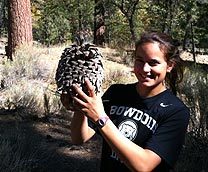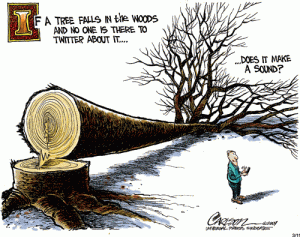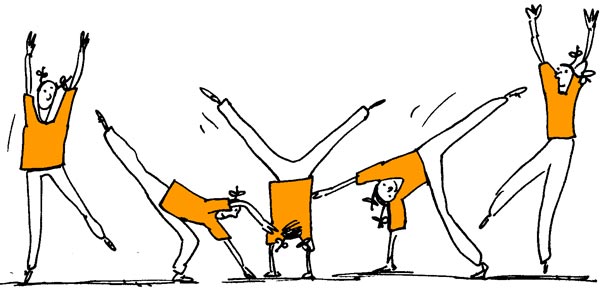When we lose our innocence- when we start feeling the weight of the atmosphere and learn that there’s death in the pot- we take leave of our senses. Only children can hear the song of the male house mouse. Only children keep their eyes open.
 In the book Pilgrim at Tinker Creek, Annie Dillard provides beautifully detailed descriptions of nature, the flow of a creek, the shadow of a tree, the meal of a giant water bug. But in the midst of these descriptions she recognizes that really we only see what we expect and are taught to see. Children on the other hand, have new and open eyes. They notice things that many of us gloss over, or don’t think are important.
In the book Pilgrim at Tinker Creek, Annie Dillard provides beautifully detailed descriptions of nature, the flow of a creek, the shadow of a tree, the meal of a giant water bug. But in the midst of these descriptions she recognizes that really we only see what we expect and are taught to see. Children on the other hand, have new and open eyes. They notice things that many of us gloss over, or don’t think are important.
One of many stories entertained by this book is that of a young blind girl who gets an operation that allows her to see. Walking into a garden, “She is greatly astonished, and can scarcely be persuaded to answer, stands speechless in front of the tree, which she names on taking hold of it… as the ‘tree with the lights in it.’” This girl does not know the name or structure of the tree, having never seen one before. She is simply aware of the beauty in its form, the wonder of the natural world.
From Wikipedia: Pilgrim at Tinker Creek is a 1974 nonfiction narrative book by American author Annie Dillard. Told from a first-person point of view, the book details an unnamed narrator’s explorations near her home, and various contemplations on nature and life. The title refers to Tinker Creek, which is outside Roanoke in Virginia’s Blue Ridge Mountains. Dillard began writing Pilgrim in the spring of 1973, using her personal journals as inspiration. Separated into four sections that signify each of the seasons, the narrative takes place over the period of one year.
 Many of our students have never been out of the city before. Seeing our forest for the first time, are they like this young girl, awed by its natural beauty? Or is it too late? Growing up too fast in the fast paced city world filled with celebrities and pop culture limits open-minded wonder and curiosity. We must take advantage of their time in the forest to remind them. The woods are a place where it is easy to discuss and understand how organisms relate to each other. “What if I fell in a forest? Would a tree hear?” Can trees sense what is going on around them? Do they have their own form of communication? How do we understand ourselves in relation to trees? In her writing, Dillard provides countless questions that will inspire thoughtful curiosity in our students throughout the week.
Many of our students have never been out of the city before. Seeing our forest for the first time, are they like this young girl, awed by its natural beauty? Or is it too late? Growing up too fast in the fast paced city world filled with celebrities and pop culture limits open-minded wonder and curiosity. We must take advantage of their time in the forest to remind them. The woods are a place where it is easy to discuss and understand how organisms relate to each other. “What if I fell in a forest? Would a tree hear?” Can trees sense what is going on around them? Do they have their own form of communication? How do we understand ourselves in relation to trees? In her writing, Dillard provides countless questions that will inspire thoughtful curiosity in our students throughout the week.
 Of course, spending time in a beautiful forest ecosystem is not just an opportunity for our students; it is an opportunity for us as well. We can push ourselves beyond just curiosity. Living in an incredible natural place gives us the ability to contemplate the connections between life forms and where we fit in the world. Dillard explains her examination of pond organisms in jars; their general movements described by limnologist Robert E. Coker as “milling around”. Some gravitate towards light, others towards darkness. She then questions, “ To which circle am I heading? I can move around right smartly in a calm; but in a real wind, in a change of weather, in a riptide, am I really moving, or am I just ‘milling around?’” We humans feel that we are on a path with a purpose in life, but does someone look down on us from above with a microscope and watch us running in circles? In times of stress, where do we find purpose and direction?
Of course, spending time in a beautiful forest ecosystem is not just an opportunity for our students; it is an opportunity for us as well. We can push ourselves beyond just curiosity. Living in an incredible natural place gives us the ability to contemplate the connections between life forms and where we fit in the world. Dillard explains her examination of pond organisms in jars; their general movements described by limnologist Robert E. Coker as “milling around”. Some gravitate towards light, others towards darkness. She then questions, “ To which circle am I heading? I can move around right smartly in a calm; but in a real wind, in a change of weather, in a riptide, am I really moving, or am I just ‘milling around?’” We humans feel that we are on a path with a purpose in life, but does someone look down on us from above with a microscope and watch us running in circles? In times of stress, where do we find purpose and direction?
This is just one of many more philosophical questions found in Pilgrim at Tinker Creek. They leave me without any answers, just with more questions.
Thankfuly the forest is a safe place to ask these questions and to push ourselves towards greater understanding of our place in this world. And we must push ourselves not only mentally, but also physically. “If I feel like turning cartwheels- and I do- why don’t I learn to turn cartwheels, instead of regretting that I never learned as a child?” Why not ask questions? Why not try new things? Why not be silly? Why not be serious? There is room in our forest.

Overall, Pilgrim at Tinker Creek is a dense book to read. You must carefully ponder the words on each page, and sometimes it is hard to pick out the meaning or direction of the story.
It is full of incredible descriptions of the natural world, so rife with details that I could reconstruct the scene exactly. But it’s funny. My brain doesn’t form an image of what Dillard is writing about. Instead these descriptions conjure up images of my favorite childhood memories, exploring a stream, or dancing under a great sycamore. At High Trails, I hope we can help our students develop those memories that will come back to them later, remind them of the wonder of nature, and one day perhaps they will find their own “tree with the lights in it.”
At High Trails Outdoor Science School, we literally force our instructors to write about elementary outdoor education, teaching outside, learning outside, our dirty classroom (the forest…gosh), environmental science, outdoor science, and all other tree hugging student and kid loving things that keep us engaged, passionate, driven, loving our job, digging our life, and spreading the word to anyone whose attention we can hold for long enough to actually make it through reading this entire sentence. Whew…. www.dirtyclassroom.com

Comments are closed.